|

About the Medal of Honor
On December 9, 1861 Iowa Senator James W. Grimes introduced S. No. 82 in the United States Senate, a bill designed to "promote the efficiency of the Navy" by authorizing the production and distribution of "medals of honor." On December 21st the bill was passed, authorizing 200 such medals be produced "which shall be bestowed upon such petty officers, seamen, landsmen and marines as shall distinguish themselves by their gallantry in action and other seamanlike qualities during the present war (Civil War)." President Lincoln signed the bill and the (Navy) Medal of Honor was born.
Two months later on February 17, 1862 Massachusetts Senator Henry Wilson introduced a similar bill, this one to authorize "the President to distribute medals to privates in the Army of the United States who shall distinguish themselves in battle." Over the following months wording changed slightly as the bill made its way through Congress. When President Abraham Lincoln signed S.J.R. No. 82 on July 12, 1862, the Army Medal of Honor was born. It read in part:
"Resolved by the Senate and House of Representatives of the United States of America in Congress assembled, That the President of the United States be, and he is hereby, authorized to cause two thousand "medals of honor" to be prepared with suitable emblematic devices, and to direct that the same be presented, in the name of the Congress, to such non-commissioned officers and privates as shall most distinguish themselves by their gallantry in action, and other soldier-like qualities, during the present insurrection (Civil War)."
|
Sgt. Nicholas S. Bouquet
November 14, 1842–December 27, 1912
Compiled by Sharon R. Becker, January of 2012
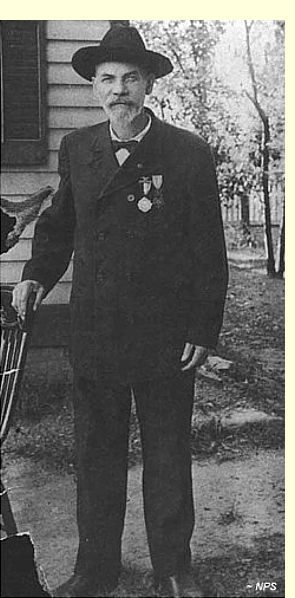
Nicholas S. Bouquet was born on November 14, 1842 in Landau, Bavaria
(Germany). In 1856 he immigrated to St. Louism Missouri when he was 13 years
old. Nicholas' mother had sent him to live with his brothers in America and to avoid service in the German army. Nicholas learned the trade of a coopersmith. He moved to Burlington, Iowa, three years later to work his trade.
Nicholas enlisted at the age of 19 on April 23, 1861, and was mustered into service with Company D of the 1st Iowa Infantry on May 14th.
In August of 1861, Confederate forces from Missouri, Texas, Louisiana, Arkansas and the Cherokee Nation moved to secure Missouri as a Confederate State. General Nathaniel S. Lyon moved his force of Missouri, Iowa, Kansas, and U.S. Army units to stop them.
Lyon's men marched during blistering August days with bleeding feet and parched lips. Lyon himself urged the weary and footsore stragglers forward.
At 5:00 a.m. on August 10th, just four days before the Iowa regiment was to be mustered out, General Lyon attacked the Confederate forces at Wilson's Creek. He sent 1,200 troops under Colonel Franz Sigel in a disastrous attack on the Confederate rear. General Lyon led the remaining 4,200 troops which included the 1st Iowa Infantry against the Confederate encampment of 12,000.
The 1st Iowa and the 2nd Kansas opened with deadly fire upon the cornfield. The Confederates were thrown into a state of disorder. Captain Totten's battery, which had been brought into action by section and by piece as the ground would permit, performed extraordinary service. Many times the firing was one continuous roar.
For nearly five hours the battle moved back and forth. General Lypn, wounded twice and having one horse killed, continued to command the action. Company A was placed in support of Totten's Battery and helped repel cavalry and infantry attacks on the Union position. When General Lyon was killed the battle shifted in favor of the Confederates.
Major Samuel D. Sturgis of the 1st U.S. Cavalry assumed command and held until a lull in the fighting. At this point, with exhausted troops and ammunition running low, Major Sturgis retreated toward Springfield, leaving the Confederates in control of much of Missouri.
It is at this point that a gunner from Captain Totten's U.S. Battery called for assistance in saving a disabled gun after one of the horses had been killed. The gun was located on the skirmish line and under heavy fire. Private Bouquet came to his aid. Under constant fire of the approaching enemy, Private Bouquet retrieved a loose horse and roped it to the gun. His action saved the weapon from capture.
The Union forces lost 944 killed and wounded. Confederate losses were estimated at 1,222 killed, wounded, and missing.
For his action on August 10, 1861 at Wilson's Creek, Missouri, Pvt. Nicholas Bouquet was awarded the Congressional Medal of Honor on February 16, 1897. His citation reads:
"Voluntarily left the line of battle and exposing himself to imminent danger from heavy enemy fire, assisted in capturing a riderless horse between the lines, and hitching him to a disabled gun, saved the gun from capture."
 Private Bouquet was mustered out on August 21, 1861. He re-enlisted as a 4th Sergeant on July 5, 1862 and was mustered into Company E of the 25th Iowa Infantry. Sgt. Bouquet fought in the siege of Vicksburg; the Battles of Chattanooga, Lookout Mountain, and Missionary Ridge; the Atlanta campaign; Battle at Kennesaw Mountain; and participated in the "March to the Sea" and the Carolinas campaign.
Sgt. Bouquet was mustered out of service on June 6, 1865 in Washington, D.C. He had served with distinction with both the 1st and 25th Iowa Infantries.
Shortly after his enlistment with the 25th Iowa, Nicholas married Elizabeth Lang, born on November 17, 1845. They were the parents of 10 children.
Upon returning from the war, Nicholas was a shop keeper and later was a policeman. For a short period of time he served as Sergeant at Arms for the Iowa House of Representatives in Des Moines. Nicholas owned a restaurant in Burlington at the time of his death. Private Bouquet was mustered out on August 21, 1861. He re-enlisted as a 4th Sergeant on July 5, 1862 and was mustered into Company E of the 25th Iowa Infantry. Sgt. Bouquet fought in the siege of Vicksburg; the Battles of Chattanooga, Lookout Mountain, and Missionary Ridge; the Atlanta campaign; Battle at Kennesaw Mountain; and participated in the "March to the Sea" and the Carolinas campaign.
Sgt. Bouquet was mustered out of service on June 6, 1865 in Washington, D.C. He had served with distinction with both the 1st and 25th Iowa Infantries.
Shortly after his enlistment with the 25th Iowa, Nicholas married Elizabeth Lang, born on November 17, 1845. They were the parents of 10 children.
Upon returning from the war, Nicholas was a shop keeper and later was a policeman. For a short period of time he served as Sergeant at Arms for the Iowa House of Representatives in Des Moines. Nicholas owned a restaurant in Burlington at the time of his death.
Nicholas S. Bouquet died at the age of 70 years on December 27, 1912. Elizabeth (Lang) Bouquet died on March 3, 1923. They were interred at Aspen Grove Cemetery, Burlington, Iowa.
On Friday, August 5th, 2011, members of the 49th Iowa performed a wreath laying ceremony at the grave of Nicholas Bouquet, Iowa's 1st Medal of Honor recipient, at the Aspen Grove Cemetery in Burlington, Iowa. Private Bouquet of Company D, 1st Iowa Infantry saw action at Wilson's Creek near Springfield, Missouri, on August 10th, 1861.
READMORE ABOUT IT:
Iowa's Medal of Honor Recipients, IAGenWeb's Iowa in the Civil War
|
Sergeant John W. Knox
Born 1851
Compiled by Sharon R. Becker, January of 2012
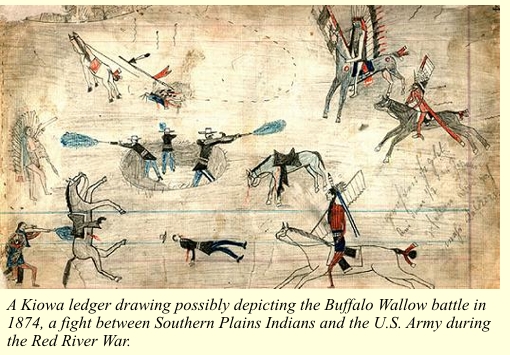 John W. Knox was born in 1851 at Burlington, Iowa. Entering the U.S. Army at Fort Leavenworth, Kansas, he was a Sergeant with Company I of the 5th U.S. Infantry.
The Kiowa and Comanche People were displaced from the Black Hills of South Dakota and settled in Oklahoma and Texas. The American government forced them onto a reservation that is today's State of Oklahoma. Seeing their land taken by white settlers, losing their ancestral traditions, resenting the slaughter of the buffalo, and dissatisfied with conditions on the reservation, the Kiowa and Comanche People, along with other tribes, raided settlements throughout the southern Plains.
The Medicine Lodge Treaty, signed near present-day Medicine Lodge, Kansas in 1867, set aside two reservations in Indian Territory (present-day Oklahoma). One was for the Comanche and Kiowa; the other for the Southern Cheyenne and Arapaho. In exchange, the Indians agreed to cease raiding and attacking white settlements. The problem was that the treaty wasn't ratified and many of the tribes didn't participate in the negotiations. The treaty for the most part was widely ignored.
In 1870, a new technique was developed for commercially tanning buffalo hides. Once numbering in the tens of millions, the buffalo population was becoming all but extinct. The Plains Indians found themselves in a state of crisis by the winter of 1873-74. The buffalo was the hub of their nomadic way of life. Without the buffalo, the Plains Indians had no means of self-support.
During the winter, a spiritual leader, Isa-tai (White Eagle), rallied the Quahadi Band of Comanches. Isa-tai had the power to render himself and others invulnerable to their enemies and bullets. On June 27, 1874, Isa-tai and Comanche Chief Quanah Parker led around 250 warriors on an attack that would be known as the Second Battle of Adobe Walls (the first in 1864). The encampment consisted of a few buildings that were occupied by 28 men and 1 woman. The whites barricaded themselves inside and held off the attack with their large caliber buffalo guns.
The surviving Comanche warriors scattered and raided all along the frontier. The U.S. Government was taken by surprise and the policy of peace of the GRANT administration was considered a failure.
The U.S. Army was authorized to subdue the violence using whatever force was necessary.
The Red River War The Red River War, a.k.a. Red River Bridge War, was a military campaign launched by the U.S. Army in 1874 with the mission of removing the Comanche, Kiowa, Southern Cheyenne and Arapaho People and forcibly relocated them in Indian Territory. At the time roughly 1,800 Southern Cheyenne, 2,000 Comanche, and 1,000 Kiowa People remained at large. Combined, the Indian force was about 1,200 warriors.
The War lasted only a few months as fewer and fewer Indian bands had the strength and supplies to remain in the field.
General Phillip Sheridan ordered 5 columns to converge in the general area of what is today's Texas Panhandle. The troopers' specific target was in the upper tributaries of the Red River. Sheridan's strategy was to deny the Indians a safe haven and attack them unceasingly until they surrendered and permanently removed to the reservations.
Of note, historically, the Apache People had dominated the western Red River area until they were displaced by the Comanche Nation coming in from the north.
Col. Ranald S. Mackenzie had command of three of the columns: Lt-Col. John W. Davidson came from Fort Still with the 10th Cavalry; Lt-Col. George P. Buell and the 11th Infantry came northwest from Fort Griffin; Col. Mackenzie led the 4th Cavalry north from Fort Concho; Col. Nelson A. Miles came south from Fort Dodge with the 6th Cavalry and the 5th Infantry; and, Maj. William R. Price marched east from Fort Bascom in New Mexico with the 8th Cavalry.
Sgt. John W. Knox was with Company I of the 8th Cavalry.
The Army, consisting entirely of soldiers and scouts, sought to engage the Indians whenever the opportunity arose. The Indians, traveling with women, children and elderly, attempted to avoid the Army as best they could. When the two forces collided, the Indians tried to flee before they were forced to surrender. This proved to be quite costly when they were forced to leave horses, food and equipment behind. The Army, however, had an essentially limitless supply and equipment at their disposal. Anything the Indians left behind was seized by the Army; what wasn't of use to them was burned.
As many as 20 engagements took place across the Texas Panhandle.
The summer of 1874 was brutal. It was exceptionally hot and dry with consistent temperatures over 100 degrees. Water holes drive up. Locusts devoured what little grass was left. Intense storms turned the dusty earth into vast expanses of mud.
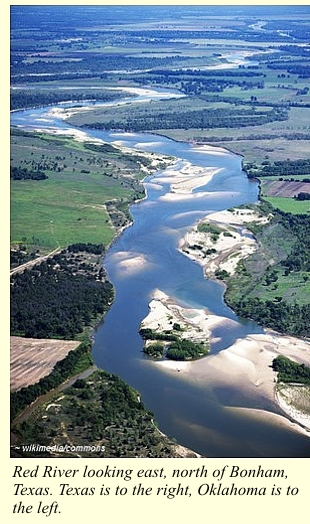 Col. Miles and his troopers had completed a grueling march and stopped to rest at a watering hole. Captain William Lyman and 56 soldiers along with teamsters and 36 wagons were dispatched to resupply the 5th Cavalry. On the return trip, the supply train encountered a violent thunderstorm which drenched the trail and slowed them down. Col. Miles and his troopers had completed a grueling march and stopped to rest at a watering hole. Captain William Lyman and 56 soldiers along with teamsters and 36 wagons were dispatched to resupply the 5th Cavalry. On the return trip, the supply train encountered a violent thunderstorm which drenched the trail and slowed them down.
On September 9, 1874, 300 Kiowa and Comanche warriors attacked the supply train, coming up on the rear at the divide between the Canadian and Washita Rivers. After a chase, the supply train took their stand with circled wagons.
The next four days were intense. The troopers, however, were able to hold off the siege until reinforcements arrived. The incident has been called the Lyman Wagon Train Battle. Sgt. Knox's actions during this engagement have not been documented.
For his action on September 9, 1874 at Red River County, Texas, Sgt. John W. Knox was awarded the Congressional Medal of Honor on April 23, 1875. His citation reads: "Gallantry in action."
Had the supply train been taken, the Red River War would probably had lasted much longer. A month later, Col. Mackenzie and his troopers found and destroyed a large Indian encampment, including the horse herd and precious supplies, in upper Palo Duro Canyon. This made it nearly impossible for the Indians to continue and they began to surrender. In June of 1875, Quanah Parker and his Quahadi Comanche entered Fort Still and surrendered. By the spring of 1875, hostilities ended in the northern Texas plains. The Indians unhappily settled onto their reservations. Gen. Sheridan separated the war leaders from the rest of the population. It was the final military defeat of the once powerful Southern Plains tribes. The Texas-Indian War was over.
Sgt. Knox was a "lifer" and served from 1873 to 1893 in the military. He retired due to health reasons and was given a pension. He lived in a soldier's home in Washington, D.C., and died in Philadelphia, Pennsylvania.
READMORE ABOUT IT:
Red River Indian War
Red River Mississippi Watershead
|
Sergeant Lewis Pfeiff
Born 1851
Compiled by Sharon R. Becker, January of 2012
 Lewis Pfeiff was born near Burlington, Iowa, on October 31, 1841, the son of Conrad Pfeiff (1810-1875) and Elizabeth (Abel) Pfeiff (1818-1893). The family's surname is usually spelled "Phife" and Lewis' name has also been spelled "Louis." Family descendants say the proper spelling is "Lewis Pfeiff." Lewis Pfeiff was born near Burlington, Iowa, on October 31, 1841, the son of Conrad Pfeiff (1810-1875) and Elizabeth (Abel) Pfeiff (1818-1893). The family's surname is usually spelled "Phife" and Lewis' name has also been spelled "Louis." Family descendants say the proper spelling is "Lewis Pfeiff."
Conrad Pfeiff immigrated to America from Darmstadt, Germany.
At the age of 19, Lewis moved to Oregon and farmed until he enlisted at Marion, Oregon, and served with the 1st Regiment of the Oregon Infantry from 1864 to 1866.
Re-enlisting in the military, he served as a Sergeant with Company B of the 8th U.S. Cavalry from 1868 to 1871.
Sgt. Pfeiff and the 8th Cavalry participated in the grueling war during the 1860's against the Hualapai (a.k.a. Pais) Apache. The Apache People resented the incursion of American settlers, ranchers, and miners in the Arizona Territory, which was their ancestral land. Apache warriors struck back with quick raids along transportation routes and then fled. Sgt. Pfeiff'S cavalry unit, among others, set out to subjugate this feared enemy. Outnumbered and out-armed, the Apache warriors held out for two years.
According to the book Deeds of Valor (1906), Troop B was one of two units "constantly engaged in encounters with the Indians, but the principal work was done and the greatest hardships endured during the months of August, September and October.
The persistent efforts of Phife's (sic) unit significantly helped in keeping the territory open to white settlement."
The description below gives a general idea of the nature of the fighting and the prevailing view as to how Americans regarded their adversary:
"During these months the Indians were murdering men, women and children mercilessly and stealing live stock and other property . . . The Apaches did not give battle to the troops except when cornered by them; their idea being primarily to steal, and then to kill without being killed. Many times . . . not more than fifty or sixty men, attacked from ambush, and before the startled troopers could respond the redskins fled to their mountain strongholds, where if by chance they succeeded in carrying a prisoner they would inhumanly torture him."
Sgt. Pfeiff served as an advance scout for this troop, constantly in the saddle and on patrol for hostile Apache warriors.
Engagements included Walnut Grove, Arizona, 13 August 1868, with Company L of the 8th U.S. Calvary under the command of Lt. A. B. Wells. Three warriors were killed. On October 21, 1868, there was an engagement between Forts Verde and Whipple, Arizona, with a Company of the 8th U.S. Calvary and detachments of Company G of the 14th U.S. Infantry acting as mail guards. One trooper was wounded.
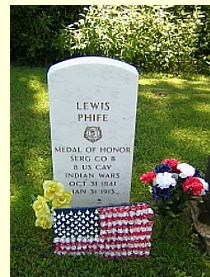 Sgt. Pfeiff's actions from August to October of 1868 in Arizona Territory aren't fully documented, but for them he was awarded the Congressional Medal of Honor on July 24, 1869. His citation reads: Sgt. Pfeiff's actions from August to October of 1868 in Arizona Territory aren't fully documented, but for them he was awarded the Congressional Medal of Honor on July 24, 1869. His citation reads:
"Bravery in scouts and actions against Indians."
Sgt. Pfeiff concluded his military service and moved back to Iowa.
Lewis married Louisa or Louise Witte, daughter of Simon and Sophia Witte of Flint River Twp., in 1873. Louisa was born in 1849, and died June 15, 1882. She is buried at Rock Spring cemetery, Des Moines county.
Lewis married, second, on February 16, 1883, Burlington, Iowa, to Wilhelmina Fredericka Louisa "Minnie" Koenig.
Lewis Pfeiff died on January 31, 1913 at Wever, Iowa. He was interred at Terney Cemetery, Wever, Lee County, Iowa. Even in death, Sgt. Pfeiff's surname was misspelled on his gravestone.
Minnie (Koenig) Pfeiff was born on November 12, 1862, and died September 20, 1935. She was interred at Terney Cemetery.
On Veterans' Day, November 11, 2003, Oregon Governor Ted Kulongoski presented the Albany, Oregon VFW post No. 10 with a plaque in memory of Lewis Pfeiff.
READMORE ABOUT IT:
"Albany Veterans Day Events." Gazette Times. Corvallis OR. 11 Nov 2003.
(Thanksto Lynn Kopatich for assistance with the Pfeiff spelling.)
|
Jimmie Earl Howard
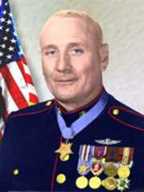 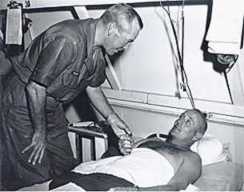 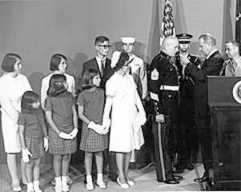
Born: 27 July 1929, Burlington, Iowa.
Rank and organization: Gunnery Sergeant (then S/Sgt.) U.S. Marine Corps, Company C, 1st Reconnaissance Battalion, 1st Marine Division.
Place and date: Republic of Vietnam, 16 June 1966.
Entered service at: Burlington, Iowa.
Citation: For conspicuous gallantry and intrepidity at the risk of his own life above and beyond the call of duty. G/Sgt. Howard and his 18-man platoon were occupying an observation post deep within enemy-controlled territory. Shortly after midnight a Viet Cong force of estimated battalion size approached the marines' position and launched a vicious attack with small arms, automatic weapons, and mortar fire. Reacting swiftly and fearlessly in the face of the overwhelming odds, G/Sgt. Howard skillfully organized his small but determined force into a tight perimeter defense and calmly moved from position to position to direct his men's fire. Throughout the night, during assault after assault, his courageous example and firm leadership inspired and motivated his men to withstand the unrelenting fury of the hostile fire in the seemingly hopeless situation. He constantly shouted encouragement to his men and exhibited imagination and resourcefulness in directing their return fire. When fragments of an exploding enemy grenade wounded him severely and prevented him from moving his legs, he distributed his ammunition to the remaining members of his platoon and proceeded to maintain radio communications and direct air strikes on the enemy with uncanny accuracy. At dawn, despite the fact that 5 men were killed and all but 1 wounded, his beleaguered platoon was still in command of its position. When evacuation helicopters approached his position, G/Sgt. Howard warned them away and called for additional air strikes and directed devastating small-arms fire and air strikes against enemy automatic weapons positions in order to make the landing zone as secure as possible. Through his extraordinary courage and resolute fighting spirit, G/Sgt. Howard was largely responsible for preventing the loss of his entire platoon. His valiant leadership and courageous fighting spirit served to inspire the men of his platoon to heroic endeavor in the face of overwhelming odds, and reflect the highest credit upon G/Sgt. Howard, the Marine Corps, and the U.S. Naval Service.
G/Sgt. Howard enlisted in the Marine Corps in 1950 and retired 13 March 1977. He died 12 November 1993 and is buried at Fort Rosecrans National Cemetery; San Diego, California
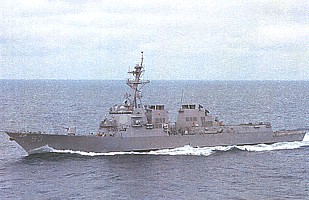
The USS Howard (DDG-83) is named in honor of Gunnery Sgt. Jimmie E. Howard, USMC, (1929-1993), recipient of the Medal of Honor for his leadership of a platoon against repeated attacks by a battalion-sized Viet Cong force. After receiving severe wounds from an enemy grenade, he distributed ammunition to his men and directed air strikes on the enemy. By dawn, his beleaguered platoon still held their position. Howard also received the Silver Star Medal for service in Korea.
More information:
USS Howard (DDG-83): http://www.uscarriers.net/ddg83history.htm
USS Howard official web site: http://www.howard.navy.mil/default.aspx
|
[If you have additional information about these men or know of other Des Moines county recipients of the Medal of Honor, please send in their names and whatever information you have for posting on this page.]
|